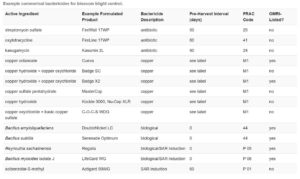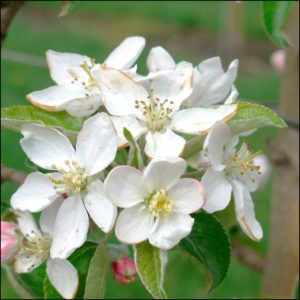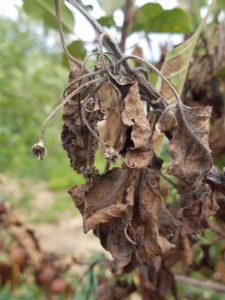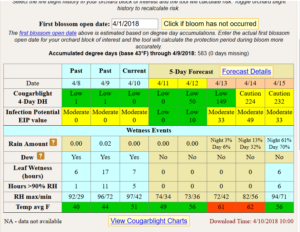Apple Disease Update: Bloom
go.ncsu.edu/readext?520282
en Español / em Português
El inglés es el idioma de control de esta página. En la medida en que haya algún conflicto entre la traducción al inglés y la traducción, el inglés prevalece.
Al hacer clic en el enlace de traducción se activa un servicio de traducción gratuito para convertir la página al español. Al igual que con cualquier traducción por Internet, la conversión no es sensible al contexto y puede que no traduzca el texto en su significado original. NC State Extension no garantiza la exactitud del texto traducido. Por favor, tenga en cuenta que algunas aplicaciones y/o servicios pueden no funcionar como se espera cuando se traducen.
Português
Inglês é o idioma de controle desta página. Na medida que haja algum conflito entre o texto original em Inglês e a tradução, o Inglês prevalece.
Ao clicar no link de tradução, um serviço gratuito de tradução será ativado para converter a página para o Português. Como em qualquer tradução pela internet, a conversão não é sensivel ao contexto e pode não ocorrer a tradução para o significado orginal. O serviço de Extensão da Carolina do Norte (NC State Extension) não garante a exatidão do texto traduzido. Por favor, observe que algumas funções ou serviços podem não funcionar como esperado após a tradução.
English
English is the controlling language of this page. To the extent there is any conflict between the English text and the translation, English controls.
Clicking on the translation link activates a free translation service to convert the page to Spanish. As with any Internet translation, the conversion is not context-sensitive and may not translate the text to its original meaning. NC State Extension does not guarantee the accuracy of the translated text. Please note that some applications and/or services may not function as expected when translated.
Collapse ▲Blossom Blight
The opening of blossoms on apple trees is usually accompanied by numerous concerns for Southeastern apple growers, with the threats of a cold snap and fire blight leading the way. As a plant pathologist, I’ll spend a majority of this post focusing on the fire blight threat and present some advice for managing the blossom blight stage of the disease.
All unprotected, open, and intact blossoms are susceptible to fire blight caused by the bacterial pathogen, Erwinia amylovora. Blossom blight is initiated during the spring as the pathogen, overwintering in cankers, begins to ooze and is disseminated to open flowers, primarily by rain splash or by insects. Upon arrival to an open blossom, bacterial multiplication occurs on the stigmatic surface of the flower, provided that enough heat units have accumulated to support reproduction. At this point the flower is not considered infected and the presence of the bacteria on the stigmatic surface presents an ideal time for agrichemical management. Even the infection of a few blossoms can set the stage for catastrophic losses later in the season, due to the systemic movement of the pathogen through xylem tissue.
Fortunately, there are two relatively accessible models that stakeholders can rely on to predict blossom blight infection: Cougar Blight and Maryblyt. Both programs can be downloaded from the internet, although Maryblyt is only available for Windows systems. Both models will require weather data inputs (temperature and precipitation/dew). Alternatively logic from both models is available on the NEWA Apple Disease Models website. While anyone can access the NEWA site, blossom blight infection predictions will only be provided for those orchards with a Rainwise Weather Station linked to the NEWA system.
Most years, blossom blight infections occur less frequently than one might think. According to the Maryblyt blossom blight infection model, four conditions must be met in order for blossom blight to occur:
- Flowers must be open and intact: Once the flower is in petal fall it becomes resistant
- The epiphytic inoculum potential (EIP) must be reached: The accumulation of a certain number of heat units during bloom must be reached to support bacterial multiplication of the flower’s stigmatic surface. In MaryBlyt, any EIP over 100 satisfies this requirement.
- A wetting event such as dew or rainfall greater than 0.01 inches: This requirement enables the movement of the bacteria from the stigmatic surface to the flower nectarthodes where infection occurs.
- Average daily temperature must be above 60F: Increases bacterial multiplication rate on stigma as well as migration rate to the nectarthodes.
In Mills River, the first blossoms on Pink Lady and Gala (both highly susceptible to fire blight) opened on March 31/April 1 2018. Generally speaking, the seasonably cool temperatures since bloom have prevented requirements #2 and #4 from being satisfied and there have NOT been any predicted blossom blight infection events in Henderson County in 2018. To demonstrate the NEWA blossom blight prediction tool, I’ve included an output generated on 4/10/18 below (click on image to make larger). The risk of a blossom infection event can be determined either using the “Cougarblight 4 Day DH” row or the “Infection Potential EIP Value” row. Using the latter to predict blossom blight, there appears to be a “moderate risk” on 4/10/18, because two conditions are met: open flowers and dew (wetting event). However, because temperatures are below 60F and because the EIP value is 0, there is not a high risk of an infection. Thus, applying streptomycin should not be necessary.
Preventative applications of streptomycin is still the gold standard for the management of blossom blight. To date, resistance has not been detected in any E. amylovora populations in the Southeast. In order to mitigate strep resistance development, the following should be considered:
- Do not apply sub-lethal rates of strep. 24 oz/A is our standard recommendation.
- Do not over-apply strep. Strep does not necessarily need to be included in every pesticide application during bloom. Refer to blossom blight infection models prior to making an application.
- Although strep does have some kick-back activity, aim to apply strep prior to a predicted infection event.
- If you believe more than 4 to 5 applications of strep will be necessary during bloom, consider applying a different antibiotic or a biological one during bloom.
An extensive list of registered products for control of blossom blight is provided. Most biologicals and resistance inducer products (e.g. Actigard or LifeGard) require application at least 24 hours in advance of a predicted infection event. Also, remember that the application of copper during bloom carries a risk of phytotoxicity.

Options for blossom blight management. Disclaimer: Those contributing to this newsletter have made every effort to provide accurate and up-to-datemanagement recommendations. However, please keep in mind that pesticide regulations are constantly changing and thus recommendations set forth in this publication should not serve as a substitute for an actual pesticide label. In addition, factors such as phenology, weather, cultivar, and tank mixtures might affect the efficacy and safety of an agrichemical product. Again, please read the label prior to use.
Apple Scab
Apple scab primary infection remains a threat across Western North Carolina. As of 4/10/2018, ascopore maturity in Henderson County is 84% and 67% of ascopores have been discharged. Make sure to continue to target scab through the primary infection period.
Bloom Fungicide Suggestions
Fungicide suggestions for bloom are similar to those used during tight cluster and pink bud. Please refer to last week’s post for fungicide options. Please note that the period from bloom through second cover presents a heightened risk for fruit and leaf phytotoxicity from agrichemical applications. Consider avoiding captan during this period and instead apply a different protectant fungicide such as mancozeb. If you must use captan, avoid using adjuvants in tank mixture and avoid applying under slow drying conditions.





